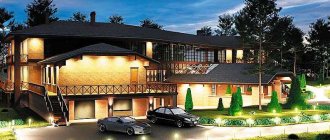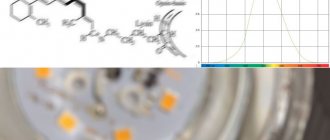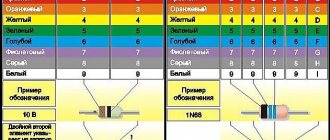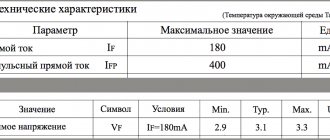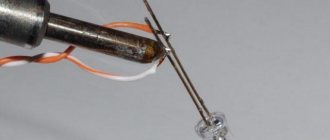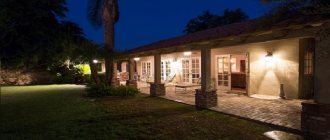May 21, 2012
The use of LEDs has become a fashionable trend in lighting technology. But does their use always give a gain, and what needs to be done to make it really noticeable? The use of LEDs for lighting a room has not raised any questions for some time now - the power is relatively small, so the lamps are already inexpensive and pay for themselves. A much more complex situation arises in outdoor lighting. High power, difficult operating conditions, high requirements for equipment - all these factors make the benefits of using LEDs not so obvious. This article compares LEDs with traditional light sources and draws conclusions about the advantages of certain outdoor lighting solutions.
In Russia, equipment is widely used for outdoor lighting, in which the following light sources are installed:
Fluorescent lamps without built-in ballasts (LL). The familiar “tubes” to everyone. They feature high light output. The disadvantage is the large size of the luminous body, which makes it difficult to focus the flow of light in the desired direction. In Russia they are used mainly for decorative outdoor lighting. At low temperatures, the light output of the lamps decreases, and problems with starting the lamp may also occur.
Fluorescent lamps with built-in ballasts (CFL). Equipped with standard bases E14, E27 or E40. Designed to replace incandescent lamps. In everyday life, such lamps are called compact fluorescent lamps, although this formulation is not entirely accurate. The fact is that there are compact fluorescent lamps with external ballasts, which, however, are not intended for installation in the indicated types of bases. Fluorescent lamps with built-in ballasts have the same advantages and disadvantages as fluorescent lamps without built-in ballasts. Their area of application is gardening lighting and decorative lighting.
Halogen incandescent lamps (HFL). For outdoor lighting, floodlights with linear GLNs with R7s socket are used. Sometimes you can find GLN with pin sockets in gardening lamps.
Metal halide lamps (MHL). These lamps combine a high color rendering coefficient and high luminous efficiency. The main area of use is architectural lighting. The MGL has a very small size of the luminous body, therefore this type of lamp is practically not used in street lamps of conventional design (if we are talking about the understanding of the term MGL used by practicing engineers, which will be discussed later) due to the large glare effect. To combat this effect, reflected light systems are used. In them, a spotlight with an MGL shines into a reflector, which is a sheet of metal coated with white paint. More advanced systems use faceted reflectors.
High pressure mercury lamps (HPL). The most common type of lamps for outdoor lighting. Provides relatively high light output and acceptable spectrum quality.
High pressure sodium lamps (HPS). Strictly speaking, NLVD is a type of MGL. But for practical applications, MGLs that produce white light and NLVDs are considered different types of light sources, their parameters are so different. The best known domestic lamps are DNaT (arc sodium tubular), which is why all NLVD lamps are often called that way. Of all the listed types, traditional light sources have the highest luminous efficiency. The main disadvantage is very poor color rendering; the light has a specific yellow tint. Since the mid-80s, the process of replacing RLVD with NLVD has been underway, primarily in Moscow and other large cities. However, due to the poor quality of the spectrum, NLVDs cannot replace RLVDs everywhere. For example, on railways in Russia the use of low-pressure cylinders is prohibited.
Energy efficiency
When people talk about LEDs, the first thing they mention among their advantages is high light output. If we look at Table 1, LEDs currently compete only with NLVDs. However, everything is not so simple here.
Table 1. Comparison of typical characteristics of traditional light sources and LEDs
| Light source type | Light output, lm/W | Service life, h | Color rendering index CRI | Dimmable |
| LL | 50…100 | 8000…20000 | 70…85 | to 10% |
| CFL | 50…60 | 8000…10000 | 70…85 | only certain lamp models, up to 15% |
| GLN | 15…20 | 2000 | 100 | up to 0% |
| MGL | 70…85 | 10000…12000 | 75…99 | only certain lamp models, up to 50% |
| RLVD | 50…60 | 8000…10000 | 60…80 | not applicable |
| NLVD | 80…150 | 10000…25000 | 20…30 | only certain lamp models, up to 50% |
| LEDs | 100…150 | 50000 | 65…90 | up to 0% |
Firstly, the NLVD gives light in all directions, while the LED only shines in one. If we are dealing with a street lamp that shines in one direction (on the road), then the NLVD will require an optical system with a reflector, for which losses of up to 35% of the luminous flux are inevitable. LEDs shine in one direction; you will need a lens to redistribute the light flux and a protective shade. In the best models of outdoor LED lamps, losses in the optical system are up to 25% (glass plus optics). A simple calculation shows that only due to this energy efficiency feature, an LED with a luminous efficiency of 150 lm/W, all other things being equal, will correspond to an NLVD with a luminous efficiency of 162 lm/W, if it were mass-produced.
Secondly, the current trend is to save money not only through increased light output, but also through more efficient control of light sources. For example, on a road where traffic flow is significantly reduced at night, you can reduce the lighting during this time and save electricity. But there are some problems with NLVD. Dimming is allowed only for certain lamp models. In practice, dimming is only possible up to 50%. In this case, the power consumption changes in a much smaller proportion, that is, there is practically no gain in energy consumption. If it is necessary to reduce energy consumption at night, lamps with low-pressure high-pressure power supply on the road are simply turned off every other time. This method of reducing illumination, although permitted by the rules, worsens the uniformity of illumination of the road surface. Therefore, from a safety point of view, it is better to use dimming rather than turning off some of the luminaires. Unlike NLVD, LEDs can be dimmed down to zero level. At the same time, which is very important, power consumption decreases in approximately the same proportion as the decrease in illumination level.
Application area
LED lamps are used for street lighting both in private facilities and in public places and enterprises, for example:
- Illumination of your own local area.
- Lighting of streets, sidewalks, roads in neighborhoods.
- Creating sufficient visibility conditions for highways, bridges, viaducts.
- Formation of the required luminous flux (in accordance with GOST standards) in workshops, warehouses, conveyors.
- Decoration of architectural, historical monuments, gardens, squares.
- Protection of territories.
Moreover, the specific area of application completely depends on the design and lighting features of the outdoor ice lamp:
- Lamps for street lamps installed on poles, supports and walls of buildings. They are used to illuminate streets, roads, squares. They are characterized by a wide scattering angle of 180 degrees, a power of up to 400 W and a luminosity of up to 5 thousand lumens, a white color tint, a high degree of dust and moisture protection, and a durability of up to 100 thousand hours.
- Spotlight for street lighting. LED backlighting of this type has a more directional focusing of the light flux than the option considered above. They use a special reflector or lens system. They are installed on objects where good visibility is required at a long distance from the light source - in stadiums, parking lots, railway stations, protected areas.
- Lamps with a wide dispersion angle (up to 360 degrees). They are installed for lighting over short distances - in gardens, parks, and streets.
- Spot. They are distinguished by a small lighting angle (ten degrees or less). They are used to illuminate a small area, for example, the front entrance.
- With motion detectors. LED lamps of this type turn on when a moving object enters the sensor’s field of operation. Used to protect or illuminate private areas.
- Decorative and advertising. The category includes various kinds of ice lamps and lamps - tubular duralight for landscape design, rulers for billboards, mesh for fences and park areas, waterproof duraflex.
Advice! Due to the high efficiency in energy consumption, the LED lamp in a street lighting lamp can be powered using a battery, which in turn can be recharged from sunlight during the day. In addition, it can be equipped with a photo relay and a motion sensor, which forces the ice element to turn on only when it gets dark and when movement of an object is detected.
Light flow
However, LED lamps have not yet replaced low-pressure high-pressure lamps from highways. The reason is that 400W HPLCs are widely used in street lighting. Their luminous flux is 48,000 lm. A lamp with such a lamp produces a luminous flux of about 30,000 lm. At the same time, the maximum luminous flux value for commercially produced street lamps using LEDs does not yet exceed 26,500 lm. In reality, they purchase and use lamps with a luminous flux of up to 18,000 lm. Approximately this luminous flux is produced by a 250 W NLVD.
With an equal flux, the subjective illumination of the object and the visibility of small details in an LED lamp will be higher than in a lamp with a low-pressure luminaire. This is due to the higher quality of the spectrum of LEDs. This circumstance allows some manufacturers to claim that their LED lamps, which have a luminous flux of, for example, 10,000 lm, are comparable to their 250 W low-pressure heat exchanger counterparts. Considerations are also added about the lower rate of drop in luminous flux of LEDs compared to NLVDs. In fact, if we are talking about a street lamp, then the very first serious check of illumination by regulatory services will show that such a lamp cannot fully replace DNAT-250 and does not meet the standards. The rules in force in Russia at the time of writing do not give concessions to lamps with a higher spectrum quality when it comes to outdoor lighting. The safety factors established by the rules are also independent of the type of light sources. Another question is that it is possible to install LED lamps with a lower luminous flux than sodium lamps where strict standards do not apply, for example, in the local area.
Color quality
Among the advantages of LEDs compared to some other light sources is better color rendering. First of all, we are talking about the significant superiority of LEDs over NLVDs in this parameter, despite the fact that both sources have comparable light output. Indeed, if the CRI for NLHD is 20...30, then for modern white LEDs from leading manufacturers it rarely falls below 60. From this we can conclude that the use of LEDs instead of NLHD may be advisable for architectural lighting, as it improves the quality of the spectrum. The exception is those cases when the illumination of a yellow hue, characteristic of NLVD, was initially determined by the architect’s plan.
If we rely only on such an indicator as CRI, then the LEDs here are approximately at the level of LL and CFL and are inferior to the best MGL samples. A series of LEDs intended for outdoor lighting, as a rule, have a CRI of no more than 80, which is due to the need to provide greater light output and, therefore, greater luminous flux. In relation to LEDs, a simple rule applies - all other things being equal, the higher the light output, the lower the CRI value.
RLDs should be considered separately - they are inferior in color rendering to LEDs, but this is not due to the principle of operation, but to purely economic reasons. RLVD technology is outdated, significant funds have not been invested in its development, moreover, street lamps based on RLVD are often positioned in the lower price segment and high requirements are not placed on the quality of color rendering of lamps.
But the CRI value only reflects the accuracy of eight colors (in the extended version - 14) and does not reflect such an indicator as spectrum continuity. For gas-discharge sources, the spectrum consists of individual lines. With LEDs it is continuous, which is a big advantage. Those. with the same CRI as a gas-discharge light source, LEDs will subjectively have better color rendition. However, so far, methods for assessing color rendering taking into account spectral continuity have not been standardized. Therefore, when designing outdoor lighting, the justification for using LEDs instead of MGLs to improve the quality of the spectrum can only be based on subjective opinion. However, there is one point that makes it advisable to use LEDs instead of MGLs. We are talking about the effect of changing color temperature over time, characteristic of MGL. Anyone can observe it, just walking around the evening city. The illumination of buildings made using MGL acquires an unpleasant greenish tint over time. It spoils the impression even more when the change in color temperature is different for lamps illuminating the same building.
Self-installation of the lantern
You don't have to take any particularly complicated actions . The simplest knowledge of electrical rules is enough. If there are none at all, it is better to invite a specialist for such work to avoid troubles. It is also better to entrust the installation of an extensive network of lanterns to a specialist, because you will have to not only install the lanterns and conduct electricity to them, but also calculate the radius of lighting, its strength and other important details.
And you can install several small lamps yourself without any problems. First, you should know a few important installation aspects:
- Lanterns should not shine directly into the windows, otherwise it will be difficult to sleep at night.
- It is unprofitable to place several lamps one step away from each other. They should be distributed relatively evenly.
- Lighting should not extend into other areas.
- Switches should be reliably protected from moisture with special plastic boxes.
The cord also needs to be well protected, but not from moisture, but from cutting . If the cable is laid underground, it should be additionally protected from mechanical damage during landscaping and agricultural work.
The cord is placed in a special protective tube. And for the safety of the pipe with the cord, it is recommended to pour a layer of pebbles on top.
Such different LEDs
However, the use of LEDs in itself does not give the lamp a clear advantage in terms of technical characteristics in comparison with its “brothers”, which contain traditional highly efficient light sources. As can be seen from Table 1, LEDs are characterized by a wide range of parameters depending on the type. Therefore, superiority over DNAT in terms of luminous efficiency or over MGL in terms of CRI can be achieved by choosing certain types of LEDs.
As an example, Table 2 shows the characteristics of some types of LEDs most commonly used in outdoor lighting.
Table 2. Parameters of some LEDs most commonly used in outdoor lighting
| Type | Rated power, W | Maximum power, W | Light output, lm/W (cold white light, rated power) | Peculiarities |
| Cree XP-G | 1,2 | 4,5 | 139 | |
| Cree XT-E | 1,2 | 4,5 | 148 | |
| Cree XM-L | 6 | 9 | 150 | Supply voltage 46…55 V |
| Nichia NVSV119A | 1,2 | 4,5 | 127 | |
| Nichia NVSV219AT-H3 | 1,2 | 4,5 | 127 | |
| Philips Lumileds Luxeon Rebel LXML-PWC1-0120 | 1,05 | 4 | 124 | |
| Philips Lumileds Luxeon Rebel LXML-PW31 | 1,05 | 4 | 100 | Color temperature 5000K, normalized |
The table shows that Cree XT-E/XM-L LEDs have the highest light output. If the goal is to simplify the design of the lamp, i.e. reducing the number of LEDs, the Cree XM-L with high voltage power supply is best here. At 6W, it replaces at least five 1.2W LEDs.
It should also be noted that the advantages of LEDs can be fully realized in street lamps only when using high-quality optics produced by leading companies such as Ledil, Khatod, LedLink and some others.
Examples of lamps
In addition to numerous advantages, LED lamps have one serious drawback - high price. However, it is already being successfully overcome. An example of this is the Russian-made EcoLight EL-DKU-02-050-0021-65X (Fig. 1), the price of which is only 5900 rubles.
Rice. 1. Lamp EcoLight EL-DKU-02-050-0021-65Х
Nichia LEDs the manufacturer also reserves the right to equip it with Semileds LEDs. With a power consumption of 50 W, the luminous flux is 3400 lm. Color temperature - from 4700 to 6500K. The lamp is intended for pedestrian sidewalks and roads of category B, parks, squares, parking lots, etc.
A RKU lamp with similar parameters costs about 1,200 rubles, so it is premature to talk about the victory of LED lamps over traditional light sources. But let's look at the problem from the other side. The design of RKU lamps is too traditional. If you are installing lamps in the parking lot in front of a business center or in the gardening area around it, then you will obviously want to install designer lamps, the price of which is obviously higher than 6,000 rubles. At the same time, the EcoLight EL-DKU-02-050-0021-65X lamp will add diversity to the surrounding landscape and create a progressive image of the company whose territory it illuminates.
As for LED spotlights for architectural lighting, their cost is already comparable to the cost of lamps for MGL. One of the ways to reduce the cost of a spotlight is to use OSRAM LEDs with high-quality primary optics, which allows you to obtain a directed light flux without the use of secondary optics. This results in double savings - on additional lenses and on their installation.
the Linterna L30 LED floodlight based on OSRAM LEDs. The luminous flux is 3000 lm, which approximately corresponds to a 70 W MGL spotlight, taking into account losses in the optical system. The price of Linterna L30 is 5800 rubles. For comparison, the price of a 70-watt floodlight on an MGL is about 4,200 rubles, the cost of a spare MGL with a ceramic burner is 1,000 rubles. In total, we get a set worth 5,200 rubles.
Experts are well aware that the best lamp is the one that is specifically designed for a specific lighting project. A luminous flux that is less than necessary is bad. But it’s no less bad if the luminous flux is more than needed. At the same time, there are extra costs for the production and installation of the lamp, and light pollution of the environment occurs.
Individual small-scale production of lamps is an expensive proposition when it comes to traditional light sources. LEDs have the advantage that the power and luminous flux of the lamp can be changed within wide limits, simply by changing their quantity. The technology for producing a custom-made LED lamp was created by the Polish company ELGO Lighting Industries (Fig. 2). The minimum number of lamps in a batch is one piece. At the same time, in terms of price, such lamps are not much different from models produced in large quantities. The technology proposed by ELGO Lighting Industries for the production of custom-made lamps may be precisely the killer application for LEDs, i.e. “a killer application” that will displace traditional light sources in street lighting.
Rice. 2. ELGO Adquen OU lamp
The ELGO Adquen series of custom-made luminaires includes street and tunnel luminaires, floodlights, as well as some other types of luminaires. The ELGO Adquen OU street lamp is designed for installation on highways with medium traffic intensity, for example, regional main streets. The luminous flux for the top modification reaches 26,500 lm. The ELGO Adquen ON LED floodlight (Fig. 3) can be used for architectural lighting.
Rice. 3. LED floodlight ELGO Adquen ON
ELGO Adquen luminaires can, at the customer’s request, be assembled based on CREE LEDs of types XP-G, XP-E or XR-E. Unlike most analogues, ELGO Adquen OU lamps, as well as other lamps in the Adquen series, have shades made of tempered glass, not plastic. This is important in the conditions of a modern metropolis with its polluted atmosphere and the use of de-icing chemicals. The glass shade increases the durability of the expensive LED lamp.
The payback for LEDs is based on the assumption that they not only use less electricity, but also last longer than traditional light sources. Unfortunately, there is no uniform method for determining the service life of LED lamps, which is actively used by some manufacturers, who often indicate the operating time of LEDs before the luminous flux decreases to 50%. At the same time, the service life of the power supply is not indicated at all in the technical specifications.
Another clear example of the capabilities inherent in CREE LEDs is the street lamp STREET-150 manufactured in Russia. It uses CREE XP-G LEDs with a luminous efficiency of 132 lm/W. Moreover, their color temperature is 5600K. With a power consumption of 158 W, the luminous flux is 13360 lm. The use of Ledil optics made it possible to achieve the correct shape of the “butterfly” type KSS, ensuring uniform illumination of the road. At the same time, there are no side “emissions” on the KSS, which reduces the glare effect.
Siteco Siteco Streetlight 10 Midi LED luminaire . 4), intended for district main streets. The manufacturer claims a service life of the entire system, including the power supply, of at least 50,000 hours. At the end of the operating period, the luminous flux decreases to only 83% of the initial value. That is, LEDs must work for more than 50,000 hours for the luminous flux to be halved.
Rice. 4. Siteco Streetlight 10 Midi LED has a low lumen rate
Is it possible to assemble an LED lamp for street lighting yourself?
For those who have experience in radio engineering and self-assembly of electronics, assembling a street lighting device based on an LED lamp will not be particularly difficult. We suggest considering step-by-step instructions for making a basic circuit:
- First, you need to purchase materials - an ice light bulb (spotlight or flashlight) of the required power and degree of protection (preferably IP65), the wiring needs to be long, a switch, a distribution module, a power supply designed for the lamp. Some lamp models already contain a driver and a radiator and are designed for a 220V network.
- You will need a set of electrical installation tools.
- If the 220-volt lamp option was chosen, it will require a socket and a lampshade with a bracket or loop for hanging.
- The wiring must be connected to a pre-installed socket with a light bulb and a lampshade (or to a spotlight or lantern), following the rules of electrical installation work. The luminaire must be connected to a phase (via a switch), a neutral from the distribution module or panel, and grounding to the housing (if required).
- The power supply (when a separate low voltage light bulb is used) can be installed indoors and wired from it to the lamp.
- After connecting all contacts, the circuit is checked for reliability, the panel is turned on and the operation of the lamp is checked.
conclusions
Currently, it is difficult to draw an unambiguous conclusion about the absolute advantage of one type of lamp over another. In each specific case, careful economic calculations are required.
LEDs have already reached such a level of development (XM-L, XT-E) that it is possible to produce a lamp that is even more efficient than a product made with a sodium lamp. Of course, the initial cost of an LED lamp is quite high, but the operating costs are much lower, and in the end it may be economically feasible to use an LED lamp instead of a lamp with a sodium lamp. Taking into account that the development of LED technologies is proceeding at a fairly rapid pace, there is a constant decrease in cost and the efficiency limit has not yet been reached, we can confidently predict the inevitable and obvious superiority of LEDs over traditional, even the most efficient, light sources in the near future.
Obtaining technical information, ordering samples, delivery - e-mail
•••
